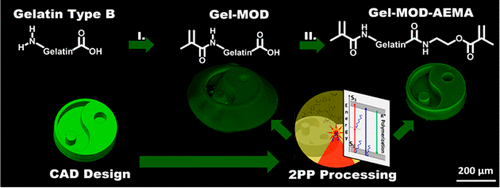当前位置:
X-MOL 学术
›
Biomacromolecules
›
论文详情
Our official English website, www.x-mol.net, welcomes your feedback! (Note: you will need to create a separate account there.)
Cross-Linkable Gelatins with Superior Mechanical Properties Through Carboxylic Acid Modification: Increasing the Two-Photon Polymerization Potential
Biomacromolecules ( IF 6.2 ) Pub Date : 2017-09-15 00:00:00 , DOI: 10.1021/acs.biomac.7b00905 Jasper Van Hoorick 1, 2 , Peter Gruber 3 , Marica Markovic 3 , Maximilian Tromayer 3 , Jürgen Van Erps 2 , Hugo Thienpont 1, 2 , Robert Liska 3 , Aleksandr Ovsianikov 3 , Peter Dubruel 1 , Sandra Van Vlierberghe 1, 2
Biomacromolecules ( IF 6.2 ) Pub Date : 2017-09-15 00:00:00 , DOI: 10.1021/acs.biomac.7b00905 Jasper Van Hoorick 1, 2 , Peter Gruber 3 , Marica Markovic 3 , Maximilian Tromayer 3 , Jürgen Van Erps 2 , Hugo Thienpont 1, 2 , Robert Liska 3 , Aleksandr Ovsianikov 3 , Peter Dubruel 1 , Sandra Van Vlierberghe 1, 2
Affiliation

|
The present work reports on the development of photo-cross-linkable gelatins sufficiently versatile to overcome current biopolymer two-photon polymerization (2PP) processing limitations. To this end, both the primary amines as well as the carboxylic acids of gelatin type B were functionalized with photo-cross-linkable moieties (up to 1 mmol/g) resulting in superior and tunable mechanical properties (G′ from 5000 to 147000 Pa) enabling efficient 2PP processing. The materials were characterized in depth prior to and after photoinduced cross-linking using fully functionalized gelatin-methacrylamide (gel-MOD) as a benchmark to assess the effect of functionalization on the protein properties, cross-linking efficiency, and mechanical properties. In addition, preliminary experiments on hydrogel films indicated excellent in vitro biocompatibility (close to 100% viability) both in the presence of MC3T3 preosteoblasts and L929 fibroblasts. Moreover, 2PP processing of the novel derivative was superior in terms of applied laser power (≥40 vs ≥60 mW for gel-MOD at 100 mm/s) as well as post-production swelling (0–20% vs 75–100% for gel-MOD) compared to those of gel-MOD. The reported novel gelatin derivative (gel-MOD-AEMA) proves to be extremely suitable for direct laser writing as both superior mimicry of the applied computer-aided design (CAD) was obtained while maintaining the desired cellular interactivity of the biopolymer. It can be anticipated that the present work will also be applicable to alternative biopolymers mimicking the extracellular environment such as collagen, elastin, and glycosaminoglycans, thereby expanding current material-related processing limitations in the tissue engineering field.
中文翻译:

通过羧酸改性具有优异机械性能的可交联明胶:增加双光子聚合潜能
本工作报告了光致交联明胶的开发,该明胶具有足够的通用性,可以克服当前的生物聚合物双光子聚合(2PP)工艺的局限性。为此,伯胺和明胶类型B的羧酸均通过可光交联的部分(最高1 mmol / g)官能化,从而产生了优异且可调节的机械性能(G(从5000到147000 Pa),可实现高效的2PP处理。使用完全官能化的明胶-甲基丙烯酰胺(gel-MOD)作为基准,在光诱导交联之前和之后对材料进行深度表征,以评估官能化对蛋白质性质,交联效率和机械性质的影响。此外,在MC3T3前成骨细胞和L929成纤维细胞的存在下,对水凝胶薄膜的初步实验表明其具有出色的体外生物相容性(接近100%的活力)。此外,这种新型衍生物的2PP处理在施加的激光功率(100 mm / s的Gel-MOD≥40 vs≥60 mW)以及生产后溶胀(0–20%vs 75–100%)方面均表现出色。对于凝胶-MOD)与凝胶-MOD相比。事实证明,已报道的新型明胶衍生物(gel-MOD-AEMA)非常适合直接激光书写,因为既获得了应用计算机辅助设计(CAD)的出色模仿效果,又保持了生物聚合物所需的细胞相互作用。可以预期,本发明也将适用于模拟细胞外环境的替代生物聚合物,例如胶原蛋白,弹性蛋白和糖胺聚糖,从而扩大了组织工程领域中当前与材料有关的加工限制。
更新日期:2017-09-15
中文翻译:

通过羧酸改性具有优异机械性能的可交联明胶:增加双光子聚合潜能
本工作报告了光致交联明胶的开发,该明胶具有足够的通用性,可以克服当前的生物聚合物双光子聚合(2PP)工艺的局限性。为此,伯胺和明胶类型B的羧酸均通过可光交联的部分(最高1 mmol / g)官能化,从而产生了优异且可调节的机械性能(G(从5000到147000 Pa),可实现高效的2PP处理。使用完全官能化的明胶-甲基丙烯酰胺(gel-MOD)作为基准,在光诱导交联之前和之后对材料进行深度表征,以评估官能化对蛋白质性质,交联效率和机械性质的影响。此外,在MC3T3前成骨细胞和L929成纤维细胞的存在下,对水凝胶薄膜的初步实验表明其具有出色的体外生物相容性(接近100%的活力)。此外,这种新型衍生物的2PP处理在施加的激光功率(100 mm / s的Gel-MOD≥40 vs≥60 mW)以及生产后溶胀(0–20%vs 75–100%)方面均表现出色。对于凝胶-MOD)与凝胶-MOD相比。事实证明,已报道的新型明胶衍生物(gel-MOD-AEMA)非常适合直接激光书写,因为既获得了应用计算机辅助设计(CAD)的出色模仿效果,又保持了生物聚合物所需的细胞相互作用。可以预期,本发明也将适用于模拟细胞外环境的替代生物聚合物,例如胶原蛋白,弹性蛋白和糖胺聚糖,从而扩大了组织工程领域中当前与材料有关的加工限制。



























 京公网安备 11010802027423号
京公网安备 11010802027423号